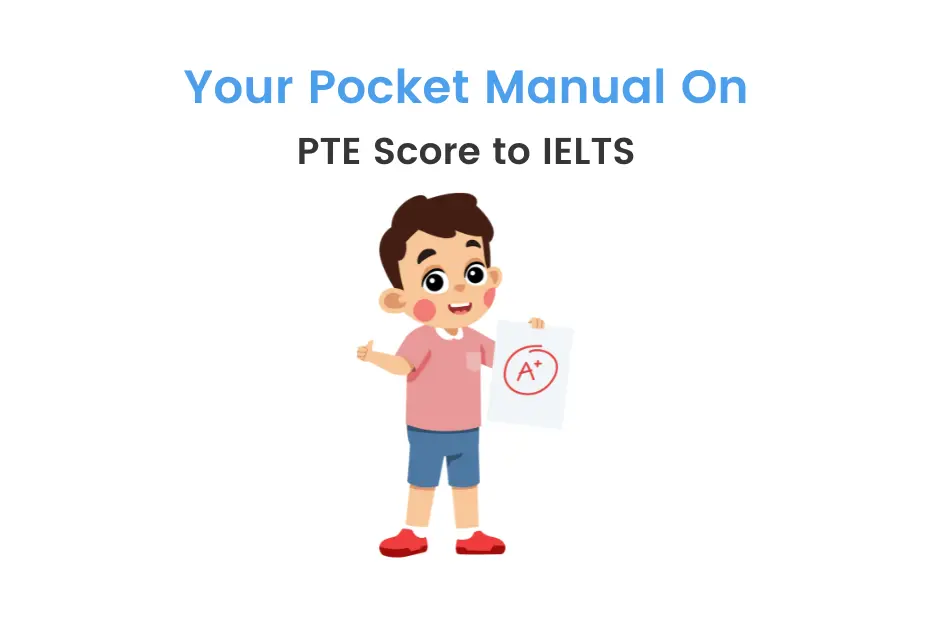In today’s interconnected world, language proficiency serves as the cornerstone for individuals striving to study, work, or settle abroad. The Pearson Test of English (PTE) and the International English Language Testing System (IELTS) have gained prominence as language assessment benchmarks. Thus, having an understanding, of the correlation between PTE scores and IELTS bands becomes paramount. If you’re considering making the transition from a PTE score to IELTS, you’re on the right page!
Did you know?
A PTE score of 70 is often considered equivalent to an IELTS score of 7.
The process of “PTE score to IELTS conversion” involves translating your performance on the PTE exam into an equivalent IELTS score, offering a crucial reference point for those embarking on international journeys. While both tests evaluate language proficiency, they differ in their evaluation criteria and formats. The PTE assesses listening, reading, speaking, and writing skills, while IELTS evaluates listening, reading, writing, and speaking abilities.
Recognizing the significance of this conversion for individuals pursuing academic and professional goals, various tools and methodologies have emerged to bridge the gap between PTE and IELTS scores. This guide will unravel the intricacies of this conversion process, providing you with insights, methods, and tips to make a seamless transition from the PTE score to the IELTS band.
All set? Come along to know more about it…
Topics covered
Why is PTE to IELTS Score Conversion necessary?
PTE (Pearson Test of English) and IELTS (International English Language Testing System) are two of the most widely recognized English language proficiency tests. They are often used by individuals seeking to study, work, or immigrate to English-speaking countries. While both tests evaluate language skills, their scoring systems and formats differ. Due to various reasons, individuals might need to convert their PTE scores to IELTS scores or vice versa.
Conversion is necessary for several purposes:
- Standardization: Conversion helps standardize scores from different tests, ensuring that individuals’ language abilities are measured consistently regardless of the test they choose. This is crucial for maintaining fairness and transparency in various application processes.
- Immigration and Education Requirements: Different countries and educational institutions have specific score requirements for language proficiency. Conversion allows authorities to equate scores accurately, enabling candidates to meet the necessary prerequisites for immigration or educational opportunities.
- Equitable Evaluation: Conversion prevents candidates from being unfairly advantaged or disadvantaged based on their test choice. It ensures that neither PTE nor IELTS candidates are favored solely due to the test’s scoring scale.
- Global Mobility: In an increasingly interconnected world, individuals often move across countries for work or study. Conversion facilitates international mobility by enabling organizations to comprehend language skills without bias toward a particular test.
- Research and Comparative Studies: Academic researchers and institutions may require cross-comparisons of language proficiency scores. Conversion assists in conducting comparative studies and generating insights into the performance of candidates from diverse linguistic backgrounds.
- Recruitment and Employment: Some employers consider language proficiency as a prerequisite for certain roles. Conversion aids in assessing candidates’ language skills accurately and transparently, helping organizations make informed hiring decisions.
How to convert PTE score to IELTS?
Converting scores between IELTS and PTE Academic (PTE-A) requires understanding their distinct scales. IELTS scores range from 1 to 9, reflecting proficiency levels, while PTE-A employs a 10 to 90 scale known as the “Global Scale of English”. To bridge the gap, a comprehensive study by IELTS Partners from 2018 to 2020 established equivalencies. However, a direct conversion formula may not exist due to differences in test structures. As of 2022, IELTS introduced the innovative “One Skill Retake”, enabling test-takers to retake specific sections. This feature employs the same 9-band scale as the full IELTS test.
To determine PTE-A to IELTS equivalency, individuals should refer to the detailed study report, ensuring accurate understanding and reliable conversions for educational and professional pursuits. However, here’s a table for your reference on PTE score to IELTS conversion:
| PTE-A | IELTS |
| 40.8 | 5 |
| 45.4 | 5.5 |
| 51.6 | 6 |
| 58.5 | 6.5 |
| 66.3 | 7 |
| 74.6 | 7.5 |
| 82.3 | 8 |
| 88.1 | 8.5 |
Official Concordance Table between IELTS and PTE
An official concordance table between IELTS and PTE Academic (PTE-A) scores facilitates understanding the relationship between these two language proficiency exams. This table is grounded in a meticulous study by the IELTS Partners conducted from 2018 to 2020.
Here’s an official concordance table between IELTS and PTE which was updated in 2021:
| IELTS | PTE-A (overall) | PTE-A (listening) | PTE-A (reading) | PTE-A (speaking) | PTE-A (writing) |
| 5 | 40.8 | 40.2 | 43.0 | 40.2 | 43.1 |
| 5.5 | 45.4 | 42.7 | 47.9 | 42.2 | 51.0 |
| 6 | 51.6 | 48.1 | 53.5 | 46.2 | 62.2 |
| 6.5 | 58.5 | 56.8 | 60.6 | 53.5 | 74.1 |
| 7 | 66.3 | 66.2 | 67.6 | 65.3 | 82.3 |
| 7.5 | 74.6 | 73.9 | 73.7 | 75.3 | 87.5 |
| 8 | 82.3 | 79.4 | 78.4 | 80.9 | 89.4 |
| 8.5 | 88.1 | 84.7 | 83.7 | 85.5 | 89.5 |
Source: https://ielts.com.au/australia/about/article-which-ielts-test-convert-ielts-to-pte-test-score
About the PTE and IELTS
PTE (Pearson Test of English) and IELTS (International English Language Testing System) are both widely recognized English language proficiency tests. They are used by individuals for various purposes, including immigration, education, and employment.
PTE assesses speaking, listening, reading, and writing skills through computer-based tasks, offering fast results. IELTS, available in both paper-based and computer-based formats, evaluates similar language skills but includes face-to-face speaking tests.
Test takers often choose between the two based on their preferences and the requirements of their intended institutions or destinations. Both tests play a crucial role in determining an individual’s English language abilities in different contexts.
Difference between PTE and IELTS
Below is a table elaborating difference between PTE and IELTS:
Test Format
PTE: The PTE exam is entirely computer-based, utilizing a range of question types, including speaking, listening, reading, and writing, all conducted on a computer.
IELTS: IELTS offers both paper-based and computer-based options. It consists of four sections: Listening, Reading, Writing, and Speaking. The speaking section is conducted face-to-face with an examiner.
Scoring System
PTE: PTE uses a comprehensive automated scoring system that assesses responses based on predefined algorithms, which can offer an objective evaluation.
IELTS: IELTS employs human examiners for the Speaking and Writing sections, potentially leading to subjective interpretation. The other sections are scored objectively.
Test Duration
PTE: The PTE exam typically takes around 3 hours to complete.
IELTS: IELTS test duration varies based on whether it is the Academic or General Training version. It usually takes around 2 hours and 45 minutes to 3 hours.
Speaking Section
PTE: The speaking section in PTE involves speaking into a microphone, and the responses are recorded and evaluated by AI algorithms.
IELTS: IELTS has a face-to-face speaking interview with an examiner, allowing for more natural interaction but potentially inducing nervousness in some test-takers.
Test Results
PTE: Results for the PTE exam are typically available within 5 business days.
IELTS: IELTS results are usually released after 13 calendar days, although some test centers offer a faster turnaround for computer-based exams.
Test Accessibility
PTE: PTE offers more frequent test dates and is available in numerous locations worldwide.
IELTS: IELTS has a broader test center network, but test dates might be slightly less frequent in some regions.
Conclusion!
Understanding the nuances of English proficiency test score conversions, particularly from PTE score to IELTS, is crucial for candidates aspiring to study abroad. While certain institutions may accept converted PTE scores, the reverse might not hold. It is advisable for prospective students to diligently review university admission guidelines to ensure compliance with their preferred test format. This awareness empowers candidates to make informed decisions, enhancing their chances of successful admission. The journey to studying abroad begins with a comprehensive grasp of these score conversion dynamics, underscoring the significance of thorough research and adherence to individual university prerequisites.
Still unsure of yourself? Why not speak with one of our knowledgeable advisors at iDreamCareer?
With the guidance of mentors from iDreamCareer, Shreya took a bold step in preparing for the NEET exam while simultaneously pursuing applications for pre-medicine programs in the United States, considering her medical history. Successfully managing the demands of both Indian and US medical entrance exams showcased her exceptional time management abilities. Shreya’s unwavering commitment and determination yielded fruitful results, as she secured impressive acceptance offers from renowned pre-med courses in the US, accompanied by valuable scholarships. Among her options including the University of Pittsburgh, Virginia Commonwealth University, University of Connecticut, Temple University, Stony Brook University, Drexel University, and Wayne University, she made a well-thought-out decision to embark on her journey at the University of Pittsburgh, where she aims to turn her aspirations into reality.
Useful Link:
- PTE – Official Website
- PTE Exam Pattern
- TOEFL vs. IELTS
- IELTS Academic Vs General Tests
- IELTS Preparation
- IELTS Syllabus
- CELPIP Vs IELTS
- IELTS Writing Topics
PTE Score to IELTS: FAQs
IELTS (International English Language Testing System) and PTE (Pearson Test of English) are standardized language proficiency tests. While both assess reading, writing, listening, and speaking skills, they differ in format and scoring. IELTS includes face-to-face speaking interviews, while PTE utilizes a computer-based speaking and writing format. IELTS uses a band score system, and PTE employs a points-based system. Understanding these differences is crucial in choosing the test that aligns with your preferences and goals.
An IELTS score of 8 is roughly equivalent to a PTE score of 82.3. It’s important to note that score equivalences can vary slightly between institutions, so candidates should refer to specific conversion charts or check with universities for precise requirements.
It depends on the institution or organization you’re applying to. Some institutions might accept PTE scores as an alternative to IELTS scores, but it’s best to check their specific requirements to be sure.
Yes, you can take both tests and submit the score that reflects your higher language proficiency. Many institutions and programs allow applicants to choose the test they prefer.
PTE scores are typically valid for two years from the test date. IELTS scores are generally valid for two years as well, but some institutions might have their policies, so it’s essential to confirm with the specific institution.

Anushree Rastogi is a Senior Content Writer at iDreamCareer, bringing over 5 years of expertise to the field of career counseling. She has done a PGDM in Marketing and Finance and possesses a unique blend of skills that allows her to craft engaging and informative content. She is passionate about helping individuals navigate their career paths and has dedicated her career to providing valuable insights through her content. Her commitment to excellence and keen understanding of the career landscape make her a trusted guide for those seeking professional direction. With a flair for clear and engaging writing, Anushree is on a mission to empower others to make informed and fulfilling career choices.










